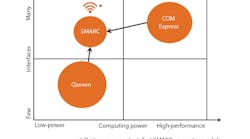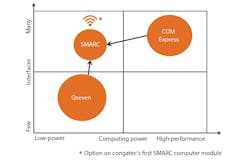With the revision of 1.1 to 2.0, SMARC has evolved to a new standard with a clear profile and unique positioning for Internet of Things (IoT)-enabled multimedia platforms as well as many other graphics-intensive low-power applications. With its numerous graphics, camera, sound, network, and optional wireless interfaces, the new SMARC 2.0 specification positions itself exactly between the two well-established module standards Qseven and COM Express.
SMARC 2.0 fits between COM Express and Qseven in the competitive landscape.
Compared to the Qseven standard, which enables low-cost entry into the world of computer modules and integrates various x86 and ARM low-power processors for the process and field levels, SMARC offers more interfaces—particularly more multimedia interfaces. Compared to the high-performance COM Express modules that make up the COM performance class, SMARC 2.0 is positioned in the low-power processor segment and supports less interfaces than COM Express.
SMARC 2.0 provides a rich array of modern serial I/Os as well as video and network interfaces, suiting it well for many multimedia and graphics-rich IoT applications. To help simplify application development, congatec has come up with optional Wi-Fi and Bluetooth in compliance with the M.2 1216 interface specification to round off the interface portfolio of SMARC 2.0 modules for IoT designs. Applications can be found in digital signage systems, commercial streaming clients, industrial thin clients and HMIs, all kinds of GUI devices, point-of-sale (POS) systems, professional gaming machines, infotainment platforms, as well as IoT gateways.

